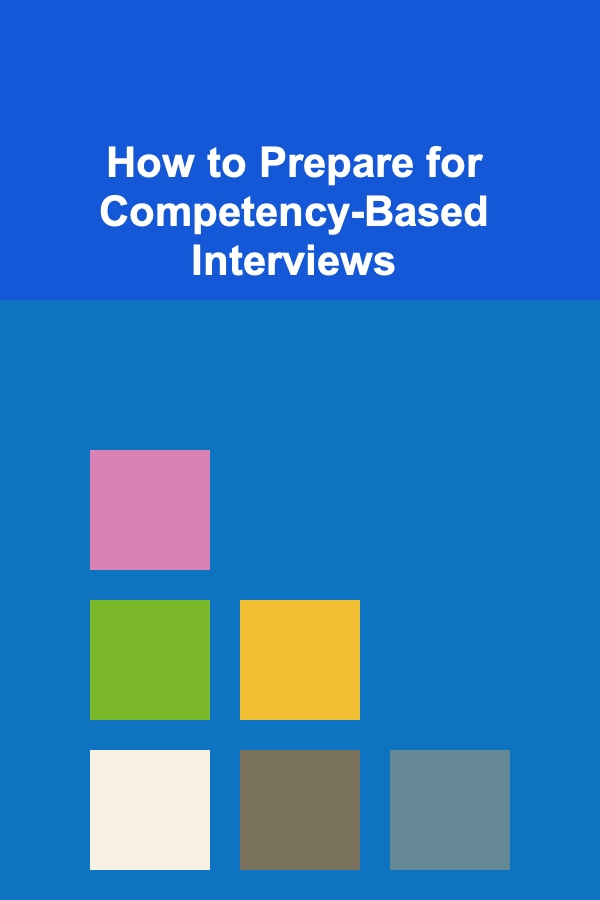
How to Prepare for Competency-Based Interviews
ebook include PDF & Audio bundle (Micro Guide)
$12.99$8.99
Limited Time Offer! Order within the next:

Competency-based interviews (CBIs) have become an increasingly common way for employers to assess candidates' abilities in a structured and objective manner. These interviews focus on evaluating past behavior and experiences to predict future performance in specific situations. Unlike traditional interviews, which might rely more on general questions or hypothetical scenarios, competency-based interviews delve into real-life examples of your past achievements and challenges.
To excel in these interviews, it's crucial to understand the underlying principles, prepare effectively, and master how to communicate your experiences in a compelling and structured way. In this article, we will explore the essential steps for preparing for competency-based interviews, strategies for answering questions, and tips for demonstrating your competencies with confidence.
Understanding Competency-Based Interviews
Competency-based interviews, sometimes known as behavioral interviews, revolve around the idea that past behavior is the best predictor of future behavior. In these interviews, interviewers will ask questions that are designed to assess your proficiency in key competencies such as teamwork, communication, problem-solving, leadership, and decision-making.
Why Are Competency-Based Interviews Important?
Competency-based interviews are widely used by employers because they provide a fair and structured way to evaluate candidates, reducing the risk of bias and making it easier to compare applicants. By focusing on actual examples of how candidates have handled situations in the past, employers can better understand their skills and attributes.
This method allows interviewers to dig deeper into your experiences, providing concrete evidence of how you perform in a work environment. They seek to determine if your past actions align with the core competencies required for the role you are applying for.
Common Competencies Assessed
In a competency-based interview, you can expect questions that assess various competencies, such as:
- Teamwork: Can you work well with others in a collaborative environment?
- Communication: How effectively do you convey information to others?
- Problem-solving: Can you identify and solve problems efficiently?
- Leadership: Have you demonstrated the ability to lead teams and projects?
- Decision-making: How do you make informed decisions under pressure?
- Adaptability: How do you adjust to new situations or challenges?
These competencies may vary depending on the job role and the organization, but they typically reflect the skills most valued in the workplace.
Steps to Prepare for Competency-Based Interviews
1. Research the Job Description
The first step in preparing for any interview is understanding the job you're applying for. The job description will give you clues about the specific competencies and skills the employer values. Make sure you read through the job description carefully and note the key attributes the employer is looking for in candidates.
- Skills: Look for the technical or soft skills mentioned in the description (e.g., communication, analytical thinking, project management).
- Responsibilities: Identify the day-to-day tasks and responsibilities to understand the competencies required to perform these tasks effectively.
- Key Attributes: Highlight any words or phrases that describe desired traits, such as leadership, teamwork, or attention to detail.
By understanding the job's competencies, you can tailor your preparation to focus on the most relevant experiences.
2. Identify Relevant Competencies
Once you have a good understanding of the role, think about the key competencies that are most likely to be assessed in the interview. Match these competencies to your past experiences and make a list of the situations where you demonstrated these skills.
For example, if the job emphasizes leadership, think of times when you have led a team, coordinated a project, or guided others toward achieving a goal. Similarly, if the role involves problem-solving, reflect on situations where you identified issues and found effective solutions.
By mapping your experiences to the competencies outlined in the job description, you'll have a solid foundation of examples to draw from during the interview.
3. Use the STAR Technique
The STAR method is a popular framework for structuring your responses to competency-based interview questions. It stands for:
- Situation: Describe the context or background of the situation you were in.
- Task: Explain the task or responsibility you had in that situation.
- Action: Detail the specific actions you took to address the task or resolve the situation.
- Result: Share the outcome of your actions, including what you learned and any positive results achieved.
Using the STAR technique helps ensure that your answers are clear, concise, and focused on the most important aspects of the experience. It also allows you to showcase your problem-solving process and the tangible impact of your actions.
Example:
Question: "Tell me about a time when you worked in a team to achieve a goal."
- Situation: "In my previous role as a marketing assistant, we were tasked with launching a new product line within a tight timeframe."
- Task: "My responsibility was to coordinate the marketing materials and ensure that the launch went smoothly."
- Action: "I organized regular team meetings to keep everyone on track, collaborated with the design team to create promotional materials, and communicated with sales to ensure they had the necessary information."
- Result: "As a result, the product launch was a success, and we exceeded our sales targets by 15% in the first quarter."
4. Prepare Multiple Examples
It's a good idea to prepare multiple examples for each competency, as you never know exactly which ones you'll be asked about. For example, you might need to demonstrate your leadership skills, your ability to manage conflict, or your problem-solving abilities. By having a range of examples ready, you can confidently respond to different types of questions.
Make sure your examples are diverse and cover a variety of scenarios. This will showcase your versatility and ability to apply your competencies in different situations. Focus on quality over quantity -- it's more effective to provide a few strong examples than to list numerous weaker ones.
5. Practice Your Responses
While it's important to prepare your answers, it's equally important to practice them out loud. Rehearse your responses to common competency-based interview questions, but avoid memorizing them word-for-word. You want to sound natural and conversational, not robotic or rehearsed.
You can practice with a friend or family member, or even in front of a mirror. Try to simulate the real interview environment as much as possible, focusing on clear articulation, body language, and tone of voice.
6. Reflect on Your Strengths and Weaknesses
Competency-based interviews often involve questions that probe both your strengths and weaknesses. It's essential to be prepared to discuss your weaknesses in a way that demonstrates self-awareness and growth. Choose a weakness that is not central to the role and explain how you've worked to overcome it.
For example, you could mention that you used to struggle with time management but have since implemented organizational tools and techniques to become more efficient. This shows that you're proactive about improving yourself.
On the other hand, you'll likely be asked to elaborate on your strengths as well. Be ready to highlight your top competencies and explain how they align with the job's requirements.
7. Demonstrate Your Soft Skills
While technical expertise is important, employers also value soft skills such as communication, collaboration, and adaptability. In your examples, make sure to emphasize your ability to work well with others, communicate clearly, and adapt to changing situations.
For instance, if you're asked about a time when you had to handle a difficult customer, you can highlight not only your problem-solving abilities but also your communication and interpersonal skills.
8. Prepare Questions for the Interviewer
Competency-based interviews are a two-way street. While you'll be assessed on your abilities, it's also an opportunity for you to learn more about the company and the role. Prepare thoughtful questions to ask the interviewer about the company culture, team dynamics, or specific challenges the organization is facing.
Asking insightful questions shows that you're engaged and genuinely interested in the role. It also helps you determine if the company and position are a good fit for you.
Final Thoughts
Preparing for a competency-based interview requires careful thought, reflection, and practice. By understanding the competencies that will be assessed, preparing concrete examples from your past experiences, and using the STAR method to structure your responses, you'll be well-equipped to succeed.
Remember that competency-based interviews are designed to assess your past performance in real-life situations. By showcasing your abilities, providing clear and specific examples, and demonstrating your passion for the role, you'll be able to make a strong impression and increase your chances of success.
Preparation is key, so take the time to reflect on your experiences, practice your responses, and approach the interview with confidence. With the right mindset and preparation, you can excel in a competency-based interview and take the next step in your career.

How to Save Space in Your Home Office with Minimalist Solutions
Read More
How To Understand the Role of Data Scientists in Esports
Read More
How to Understand the Concept of FatFIRE Without Being Rich
Read More
Feng Shui for Your Desk: Optimizing Your Workspace
Read More
How to Decipher Your Genetic Ancestry Test Results
Read More
How to Address Cultural Sensitivity in Event Programming
Read MoreOther Products

How to Save Space in Your Home Office with Minimalist Solutions
Read More
How To Understand the Role of Data Scientists in Esports
Read More
How to Understand the Concept of FatFIRE Without Being Rich
Read More
Feng Shui for Your Desk: Optimizing Your Workspace
Read More
How to Decipher Your Genetic Ancestry Test Results
Read More